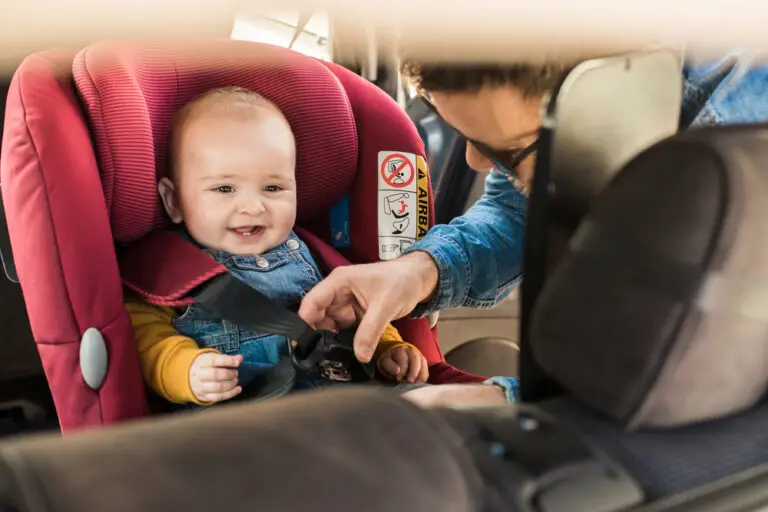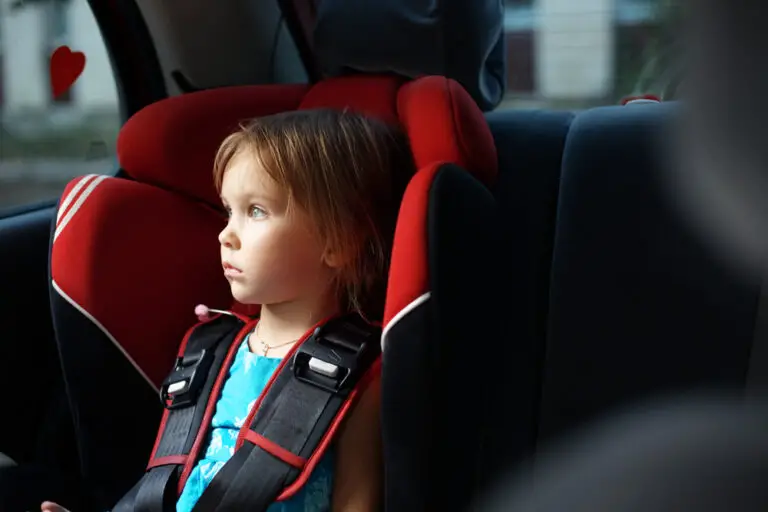Oregon Car Seat Laws 2024 (Rear, Forward & Booster)

Under Oregon car seat laws, children under the age of 8 years have to be restrained in a child passenger safety system. Those taller than 4’9” must be secured in properly fastened seat belts. A violation of the law carries a minimum fine of $65 and a maximum of $250.
Disclaimer: This content does not constitute legal advice. It is solely for informational purposes. Always check the original source of the law for the latest version.
- Rear-Facing
- Forward-Facing
- Booster
- Front Seat
- Seat Belt
- Taxi Seat
- Ridesharing Seat
- Replacement
- Alone in Car
- Choosing a Seat
- Installation Help
Oregon Car Seat Laws
Oregon Rear-Facing Car Seat Law
According to the rear-facing car seat law in Oregon, a child under the age of 2 years must be restrained in a rear-facing car seat. (1) It must never be placed in front of an active front seat airbag.
Though the rear-facing car seat age in Oregon is newborn to 2 years, an infant should continue riding in their rear-facing seat till they reach its maximum weight or height limit set by the manufacturer.
Violating Oregon rear-facing child seat law is a Class D traffic violation. The minimum fine is $65 and the maximum is $250. The presumptive fine is $115. (2)
The responsibility for ensuring that the child is safely secured rests with the parent, legal guardian or person legally responsible for the safety and welfare of the child when they are traveling with the child.
Age: Newborn to 2 years
Penalty: Minimum $65, maximum $250; presumptive fine of $115
Oregon Forward-Facing Car Seat Law
According to the forward-facing car seat law in Oregon, a child 2 years of age or older and weighing 40 pounds or less has to be secured in a forward-facing seat with a 5-point harness. (1) The harness strap must rest at or above the child’s shoulders.
The forward-facing car seat age in Oregon is not specific. Instead, there is a weight limit of 40 pounds. However, your child should continue riding in a forward-facing seat till they reach the maximum weight or height limit of the seat prescribed by the manufacturer.
The parent or legal guardian of the child has to ensure compliance with Oregon forward-facing child seat law. Disobeying the law constitutes a Class D traffic violation. While the minimum and maximum fines are $65 and $250 respectively, the presumptive fine is $115. (2)
Age: 2 to 8 years
Weight: 40 pounds or less
Penalty: Minimum $65, maximum $250; presumptive fine of $115
Oregon Booster Seat Law
According to the child booster seat law in Oregon, a child 4’9” tall or shorter and weighing more than 40 pounds must be secured in a booster seat. (1)
The seat should elevate the child so that the seat belt can properly fit them. Depending on your requirements, you can choose a high back or backless booster seat.
The booster seat age in Oregon is 8 years. But you should keep your child in a booster seat till they cross its height or weight limits set by the manufacturer.
There is a fine for violating Oregon booster seat requirements. The minimum fine is $65, the maximum is $250 while the presumptive fine is $115. (2) Children who are physically or medically unable to use a car seat are exempt from these requirements.
They must have a certificate of exemption issued by the Oregon Director of Transportation based on a signed statement by a physician, nurse practitioner or physician assistant explaining the condition. (3)
Age: Under 8 years
Height: 4’9” or shorter
Weight: 40+ pounds
Penalty: Minimum $65, maximum $250; presumptive fine of $115
Oregon Child Front Seat Law
There is no specific child front seat law in Oregon. But the State recommends keeping children in the backseat till they are 13 years old since it is safer. The American Academy of Pediatrics also recommends the same. So even though the front seat age in Oregon is absent, it is best to follow the State’s and AAP recommendations.
If it is absolutely necessary, a child can ride in the front seat. However, in case of a rear-facing seat, the passenger-side airbag must be deactivated. The child’s car seat must be appropriate for their height and weight. The vehicle seat must be pushed as far back from the airbag as possible.
You must follow these requirements to ensure complete safety of your child in the front seat.
Age: Recommended- 13+ years
Oregon Child Seat Belt Law
According to the child seat belt law in Oregon, children between 8 to 16 years of age or taller than 4’9” must wear a seatbelt. (1) It must fit snugly across their lap and shoulders. They have to wear it in the backseat as well as the front seat.
The requirements of Oregon children’s seat belt law do not apply to a child riding in a vehicle that does not have to be equipped with a seat belt under federal law. A child who is medically or physically unable to use an adult safety belt is also exempt. They must carry a certificate issued by the Department of Transportation.
The parent, legal guardian or person legally responsible for the safety and welfare of the child is liable for obeying the seat belt rules in Oregon. Not wearing a seat belt is a Class D traffic violation. It carries a minimum fine of $65 and a maximum fine of $250. The presumptive fine is $115. (2)
Age: 8 to 16 years
Height: Taller than 4’9”
Penalty: Minimum $65, maximum $250; presumptive fine of $115
Oregon Taxi Child Seat Law
According to the taxi child seat law in Oregon, taxis are not required to have a child passenger safety system in place. (4) Oregon state law does not place any liability on the driver of the taxicab to provide a car seat.
As parents and caregivers, it is best if you arrange an appropriate taxi child seat in Oregon. Depending on your child’s height and weight, you can select a rear-facing, forward-facing, or a booster car seat as per the car seat laws in Oregon. The car seat should meet federal motor vehicle safety standards and be installed as per the manufacturer’s instructions.
When installing the car seat in a taxi, you must ensure that it is securely fixed. You can refer to the car seat manual for proper installation or also ask the driver for help.
Oregon Ridesharing Child Seat Law
There is no clear ridesharing child seat law in Oregon.
Under Oregon car seat regulations, a child younger than 8 years and shorter than 4’9” inches has to be secured in an appropriate child restraint.(1) The operator as well as the parent or legal guardian of the child can be held responsible for any violation.
In the absence of a clear provision, it is best for either the driver or the parents/caregivers to provide a child seat. An infant should be placed in a rear-facing car seat. Young children should ride in a forward-facing car seat. Once they outgrow it, they should ride in a booster seat till they are big enough for the safety belt to fit them properly.
Thus, before booking a rideshare service such as an Uber or Lyft, check if the driver has a car seat or arrange one.
Oregon Child Seat Replacement Law
There is no definite child seat replacement law in Oregon. The National Highway Traffic Safety Administration (NHTSA) recommends replacing a child safety seat after an accident in Oregon.
In case of a moderate or severe crash, you should immediately replace the seat. But if it is a low impact accident, there is no urgent need to replace the car seat. A low impact crash is where no passenger is injured, the door nearest to the car seat is not damaged and the car seat itself shows no visible damage.
Apart from child seat replacement after an accident, you must also replace it after it has expired. Most manufacturers recommend not using the car seat beyond 6 years from the date of manufacture. You must also replace the car seat if it has been recalled.
Leaving Child in the Car in Oregon
According to the law on leaving a child in a vehicle in Oregon, it is illegal to leave a child , with criminal negligence, under the age of 10 years for a period of time that can endanger the health or welfare of the child. (5) The person who has custody or control of the child will be charged with child neglect in the second degree.
The most common danger of leaving a child unattended in a vehicle is heat stroke. Temperature inside the vehicle can rise rapidly. Since children’s bodies heat up faster than adults, they are at a great risk of suffering a heat stroke. Other risks include setting the car in motion, getting strangled by seat belts or power windows or having some other in-car accident.
Leaving a child in the car in Oregon is a Class A misdemeanor and carries a fine of $6250. (6)
Choosing a Child Car Seat in Oregon
Oregon child seat laws tell you which seat to choose for your child. When choosing a car seat in Oregon, you can refer to the guidelines of the OHSU Doernbecher Safety Center.
From the time your child is born till they turn at least 2 years old, a rear-facing car seat is the best car seat to use in Oregon. They can then move to a forward-facing seat with a harness and teether.
After they reach the maximum height and weight limits of the forward-facing seat, they should use booster seats. A booster seat that elevates the child to allow the seat belt to fit perfectly is the best booster seat to use in Oregon.
Car Seat Installation Help in Oregon
Installing a car seat can be a tedious task, especially if you are doing it for the first time. The seat must be secured perfectly to the vehicle as per the manufacturer’s instructions.
To help you with installing child passenger safety seats in Oregon, the state has different stations with certified Child Passenger Safety (CPS) technicians. You can get your car seat checked or installed and also learn more about child passenger safety. Some of the stations where you can get assistance are:
- OHSU Doernbecher Children’s Hospital
- Corvallis Fire Department
- Grants Pass Fire Rescue
- Albany Fire Department
- Sherwood Police Department
- Salem Health
Oregon Car Seat Safety Resources
- Doernbecher Children’s Hospital: It provides a host of resources for child seat requirements in Oregon. It has information about Oregon’s law on car seats, where you can get your car seat inspected and the best practices to ensure complete safety of your child.
- Oregon Department of Transportation: The official website of the state has comprehensive information about child passenger safety laws. It also provides a list of car set education programs and national best practices.
- CDC Buckle Up:Restraint Use- Oregon: The National Center for Injury Prevention and Control of the CDC emphasizes the importance of car seats through data. It explains Oregon’s law and initiatives to promote car seat safety.
FAQ
How long should a child ride in a rear-facing car seat in Oregon?
A child should ride in a rear-facing car seat till the age of 2 years or till they surpass the maximum height and weight limits of their rear-facing seat.
Can you put a rear-facing car seat in the front seat in Oregon?
The law is silent. However, a rear-facing car seat should be placed in the back. If you do put it in front, the front seat airbag must be deactivated.
Can you put a rear-facing car seat in the middle rear seat in Oregon?
You can put a rear-facing car seat in the middle rear seat if your vehicle has lower anchors in the middle. Check your vehicle and car seat manuals.
When can a baby face forward in a car seat in Oregon?
A child weighing less than 40 pounds can face forward after the age of 2 years when they have outgrown the maximum limits of their rear-facing seat.
How old for a booster seat in Oregon?
Children younger than 8 years and shorter than 4’9” inches should ride in a booster seat. They should transition to a booster once they outgrow their forward-facing seat.
When to use a backless booster seat in Oregon?
You can use a backless booster seat if your vehicle seat has a headrest and the child’s ears are not higher than the seat back.
When can a child sit in the front seat with a booster in Oregon?
Children should ideally ride in the backseat. But if it is unavoidable, they can ride in the front seat with a booster with the vehicle seat pushed back.
When can a child stop using a booster seat in Oregon?
A child can stop using a booster seat when they turn 8 years old or reach 4’9” in height. They can then start using the seatbelt.
When can a child sit in the front seat in Oregon?
Children should ride in the backseat as it is safer there. They can sit in the front seat after they reach the age of 13 years.
When to switch from 5 point harness to a seat belt in Oregon?
When the child outgrows the height and weight limits of the 5-point harness, they can switch to wearing a seat belt in a booster seat.
When can a child use a regular seat belt in Oregon?
Under the law, a child can start using a regular seat belt once they are 8 years old. The seat belt must fit properly across their lap and shoulders.
Do you need a car seat in a taxi in Oregon?
Taxis are not required to have a car seat. However, it is recommended that you carry an appropriate car seat for maximum protection of your child.
Do you need a car seat in a Uber in Oregon?
The law is unclear. But either the parent/caregiver or the driver should provide a federally approved and appropriate car seat for the child to avoid any violation.
Do you need a car seat in a Lyft in Oregon?
The law is not clear on this issue. But either the caregiver or the driver should provide an appropriate car seat to ensure the child’s safety.

Rishima Rawat
Rishima Rawat is a lawyer and legal writer with over six years of writing and legal experience. She earned her LLB degree from the West Bengal National University of Juridical Sciences, Kolkata. With a passion for child safety, she’s written extensively about the U.S. car seat laws in ParentingMode. She collaborates with businesses and law firms globally, enhancing their online content. Her insights are also published in legal journals like RGNUL, NLIU, and RMLNLU Law Review. Committed to the cause of education, she has volunteered with IDIA, which helps underprivileged children in India to access legal education. She has also worked with Enhelion Knowledge Ventures, a leading legal ed-tech platform in India that provides students with affordable courses in law. Fluent in English and Hindi with elementary proficiency in Spanish, Rishima combines her legal expertise with a dedication to child safety.






